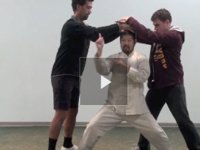-Kelvin reviewed the details of Buddha’s warrior attendant pounds the mortar, here is some of the key points.
1. Mid fingers in line with the center of the chest.
2. Imagine the left mid finger is against a wall, on the turn, the finger does not come towards the body, but keep pushing into the wall because of the rotation of the torso(one knee up one knee down). Both arms are positive circle.
3. On the fifth move, the left arm in with elbow negative circle, right arm out with hand positive circle. Both hands and elbows are coming into the line, finding a stretch from the right fingers to the left shoulder/elbow.
4. When stepping up, lead with the right elbow and right kua. Lock the left side of the body, lock the left ankle and left knee.
5. On the sixth move, the hand does not move. Right kua pushes up, right shoulder sink, elbow stays in, causing the forearm to rotate. Will look like the hand goes up, but it is the body goes under. The right buttock is going up towards the knee and the left buttock is going down towards the heel, splitting vertically.
-We also practiced three power points of the form.
1. After the first move, hands in position, then jerk the elbows in. Power is only on the elbows, can practice with hands in fists, which have just enough strength to catch the opponent. First train jerking the elbows towards the body without moving anything else, and then add on the rotation of the torso to increase the distance. On the rotation the energy is going out through the hands.
2. Shovel out. Kick with the left leg, stretch and split the left heel from the elbows while maintain the center.
3. The sixth move. The punch is going from the crotch to the chin. Lock the arm and throw the fist out with the kua. Here the shoulder is easy to pop and the hand tends to move on its own. So make sure we lock the shoulders and the hand and thrust the power from the kua to the fist. Left hand will be going down leading by the elbow creating a vertical split with the right arm.
-The lines in the body. Out of the five points (head, hands and feet), there are lines in between every two points. Like a star inside a pentagon. My understanding is each line need to be maintained and stretched, therefore you have Peng energy.

-Horizontal and vertical. In Taiji, we consider vertical is the orientation along the length of the object. Use a stick as an example, along the stick is considered vertical, anything in a different plane is horizontal.



{ 2 comments… read them below or add one }
Thank you Yuxin Liu, you have great notes.
Thank you Jack:)